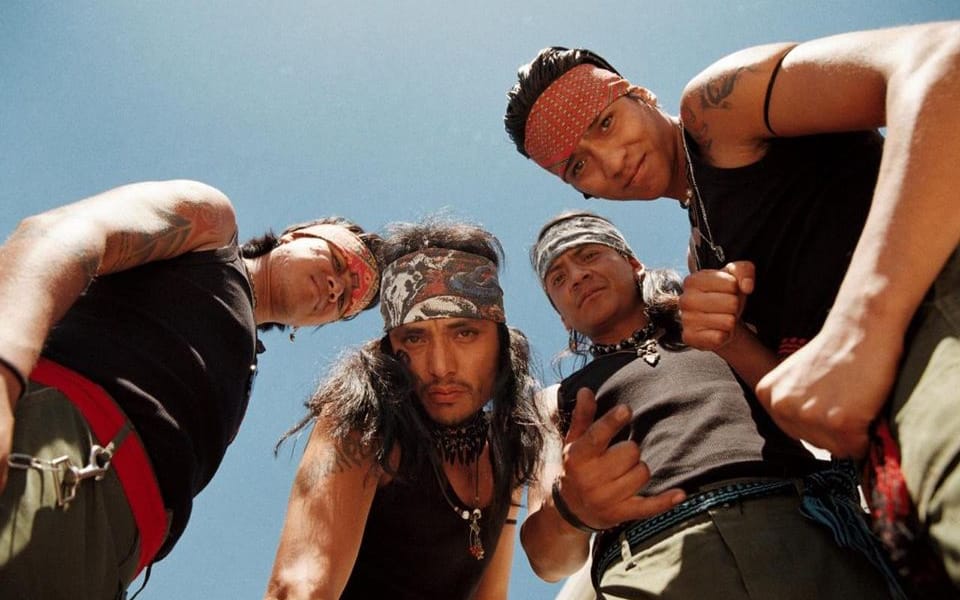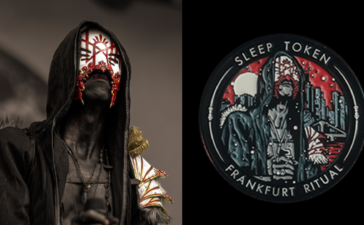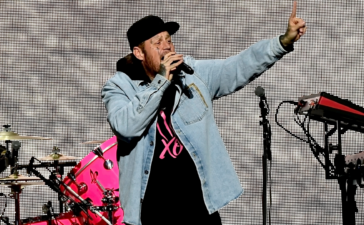It was just over a decade ago that brothers Marco Antonio, Víctor Hugo, José Alberto and Jesús Adrián Sandoval began theorising their dream of being in a rock ‘n’ roll band. What initially started off as an outlet for their fiery and fierce rock ‘n’ roll sensibilities soon turned into much more. Whatever their initial intent for plugging in and thrashing were, the brothers soon found their higher calling.
Fast forward to 2020, and word of Los Cogelones has reached the furthest corners of the globe. It’s safe to say that the group have well and truly outgrown the definition of a Nezahualcoyotl, Mexico City local band. They’ve become a beacon of inspiration for Indigenous communities all over the world, not just their own, and serve as an important lesson to non-Indigenous communities through combining elements of their traditional Aztec culture with the modern movement of punk rock.
But Los Cogelones is more than just the addition of traditional Aztec elements such as the Indigenous Nahuatl language, or ancient Mayan instruments including the huéhuetl, thrown atop a rock bed of distorted power chords. What Los Cogelones have done is create a new movement, one that combines the wisdom and depth of the past with the urgency of now.
Speaking through the band’s manager and translator Audrey Pauline Del Piccolo, Blunt Magazine caught up with Los Cogelones.
Los Cogelones is now turning heads all over the world. How does it feel to know your music is being heard by such a large international audience now?
It feels great. We’re happy because the entire world is receiving the medicine, it is no longer just for one country. People who identify with our music are on the same search; looking for a new beginning, for new ways to see the world and renew the earth. We have a common origin and a common home. And that is good for the future of humanity. We have to raise awareness. We did not imagine that it was a global need but we are receiving a lot of messages of our brothers and sisters from so many countries.
After growing up in an isolated part of the country, how did you first discover punk rock?
We discovered rock by the way in which our neighbourhood was formed: From our family. Neza’s second generation took rock and punk as their flagship. As a form of resistance. Here rock’n’roll is a way of life, it is not just listening to music.
Are there any similarities between traditional Aztec culture and punk rock culture that people may not realise?
The similarity between the Mexican tradition and punk rock is found in the dance. In the rhythm. In both, it keeps your spirit awake and alive. Restless as is their nature. It is bound by the primitive essence. Just saying what you feel, with movements. Leave reasoning behind and live.
Being ‘punk’ means something different in every city around the world. What does being ‘punk’ mean to you?
Punk for us is resistance. Restlessness. Freedom. Force. Do what you like with a lot of attitude. Smart anarchy. For some, punk is destruction. Not for us. It is a way of moving on.
I’d love to know the story behind combining traditional culture with punk rock. How did you come up with the idea, and how did you make it work so well?
We never had the intention of joining these two worlds. At first, we even wanted them to be separated. But little by little we realized that they were two linked worlds. The more we got involved in the tradition, the more it began to make sense to integrate it into our music. And everything happened in a natural way.
How have other locals from your hometown taken to your music?
People who have listened to our music have the same spiritual and physical needs to take care of ourselves. They listen to our music and they remember that we have a mission. They see us as a representation of the neighbourhood and of the Mexican tradition, an arrowhead since much of our work is linked to our people.
What are some of the stories you tell in your songs, and why are these important stories for you to tell?
The history of our songs are stories of life, we are 5 brothers. They speak of a lineage, of a “calpulli”, of a family. It is the catharsis of exile from society with the intention of seeing the world from the outside.
Since the band’s rise, have you noticed many other bands incorporating elements of their traditional culture into heavy music? Perhaps bands you have inspired! For example, check out The Hu from Mongolia or Southeast Desert Band from Australia!
We have been an inspiration but not only for the musical world, if not for the artistic world that is linked to the Mexican or native tradition. We are not the only ones doing this. Little by little we have been meeting more people who incorporate their native cultures in their artistic projects. What is certain is that over time the new generations will be able to get closer to their roots thanks to the work that is done.
Though you speak in a traditional tongue, and Spanish, is there a universal message that listeners all over the world can take away from your art?
The message is the love of your roots. It is a global message, we want harmony between all races. With different skin colors but with the same blood. Human feelings are general.
Once the pandemic is over, will you tour Australia?
We would love to visit everyone. And Australia with pleasure. We look forward to our invitation! Until now we only know the world through the screen.






